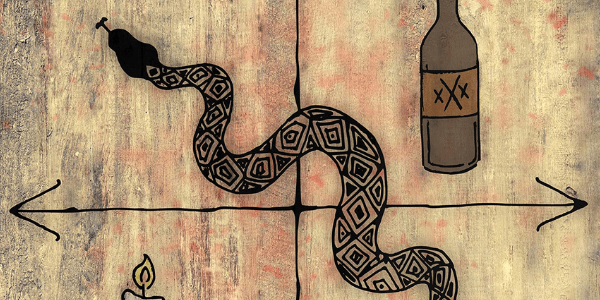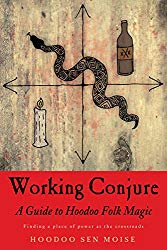Working Conjure: A Guide to Hoodoo Folk Magic, by Hoodoo Sen Moise
Weiser Books, 9781578636273, 208 pp., 2018
Working Conjure: A Guide to Hoodoo Folk Magic by Hoodoo Sen Moise is a brief introduction into the world of hoodoo, also known as rootwork. This guide focuses on working with roots that are not just plants, but also things such as nails, spikes, candles, dirt, animal organs, the spirits of the roots, spirits of locations, and your ancestors. It emphasizes that working with your ancestors and spirits is the cornerstone of doing the work in hoodoo. Boise sums it up nicely in the first chapter stating, “Conjure is an African American-based magical practice that contains influences from African spiritual practices, Christianity, Jewish mysticism and Native American practices as well as European Folk magic.”1
Many of the spells presented in this book takes days. In fact, just making some of the ingredients is time consuming, especially when working within cycles of three to seven days. If the cycle is missed, you must start all over again. The work uses a combination of your own words and particular passages out of the Bible that give a extra punch to the spell. This is just another example of how this practice is born out of adapting what was on hand, can be hidden, and yet still have the strength needed.
This is not a collection of spells to try out lightly. Moise talks about forming a relationship with the spirits — you must create a bond and give before you start asking for things such as opening the crossroads for luck or protecting the home. She writes, “When you are a spiritual worker, you will always have relationships with spirits. It sounds so simple to say, but some folks may not completely understand the concept of relationships with spirits.”2
Boise describes the importance of speaking to the spirits daily and giving them food in order to cultivate a relationship. The relationship isn’t just a matter of needing something from them. The work is more a symbiosis, rather than just taking from one side. The spirits and ancestors are partners with you in this work; they are there to help and keep balance. They will let you know if work shouldn’t be done, or it is not the right time, you just have to listen. This is a way of life and a way of working with spirits that goes beyond merely spellwork.
The first part of Working Conjure teaches about the two sides of the coin in rootwork. Moise states that the work is neither black or white, good or bad. It is a balance and a force that creates change. She writes, “What one culture considers to be morally acceptable or good may be not be considered the same in another culture.”3 Hoodoo emerged out of necessity and survival. The three-fold law or karma don’t have a place in this practice. However, if you push in a direction you shouldn’t, or disrupt the balance, it might smack you back.
Moise shows both the path of the right and left, but not how we traditionally think of the right-hand and left-hand paths in the occult. The meaning, according to him, is more the process of either opening or closing the crossroads. The work done is using the person’s own actions against them — with the help the root spirits, ancestors, and your own will.
Moise learned hoodoo through his family, and it is something he lives and breathes. Moise briefly relates the history of hoodoo, and notes that it was a magical practice that started in West Africa, and then melded and changed as enslaved peoples were moved around, and forced to adapt and survive. Essentially, this practice was born out of necessity. During this time, the people who practiced hoodoo were held against their will, had very little power and were adapting to new surroundings. They found a way to use what they had, things others might look over as simple items, that way the work would not be seen for what it truly was. Rootwork still holds this power and adapts to the changing times. It continues to give strength to those who need to take the power in their own hands and create balance.
While reading through Working Conjure, I could see the sympathethic magick in use, such as with railroad spikes put into the corners of the house to ward against foolishness. I love how he shows how to adapt the work to an apartment or rental space with flowerpots in the four corners of the house, instead of the railroad spikes, which is deemed just as effective.
One thing that fascinates me is the use of Biblical passages in the various spells to charge the work. They often need to repeated multiple times and with lots of energy, not just going through the paces. Moise writes about the power of the verse, Psalms, and proverbs within the Bible itself. As book that holds so much power for people, it would make sense that the Christian Bible would be used in magical work. It is both a combination of the power of the words and the faith of a higher being attached that add to the spell.
Working Conjure has many spells for spiritwork, uncrossing, hot foot, and much more. He writes, “The petitions need to be constant, as it adds to the potency of the work. Remember, you get out what you put in, so if your half-ass the job you get a half-ass result.”4
It has a glossary, but there is no bibliography or book recommendations provided, which I found disappointing. I understand that Moise learned much of his craft from family and teachers, but I was hoping for recommendations of some kind. I feel this book just scratches the surface of hoodoo and rootwork, and could be a companion to a multi-volume series.
Moise co-owns a shop in New Orleans and the other owner, Star Casas, also published a book last year through Weiser on hoodoo, Old Style Conjure: Hoodoo, Rootwork, & Folk Magic. It likely would go well with this one. I feel I only got a taste of what Moise knows, and the book could have been twice as long. Working Conjure is a good jumping off point for anyone curious about this practice.










